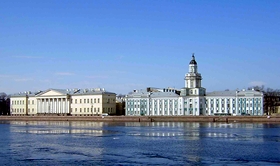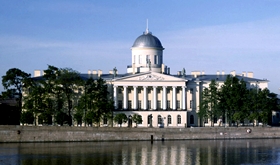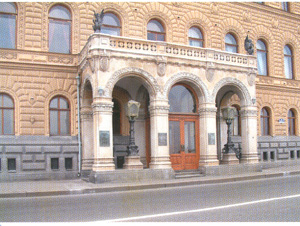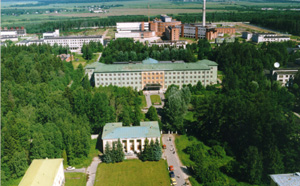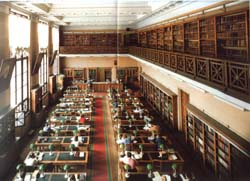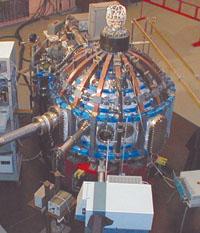You are here
Home ›About Saint Petersburg Research Center
|
The year 1999 was marked by a wide celebration of the 275th anniversary of the foundation of the Russian Academy of Sciences. February 8, the day when Emperor Peter the Great issued the edict "On the Academy of Sciences and Its Maintenance Costs", was declared the Day of Russian Science. Three hundred-year history of St. Petersburg and the history of the Russian science are most closely interrelated. In 1720s the new Russian capital witnessed the appearance of a professional scientific institution closely connected with the state and included into the world science. The Academy of Sciences was situated in our city until 1934. Half a century later Leningrad (now St. Petersburg) Research Center was formed. It is by right considered to be the historical core of the Russian Academy of Sciences.
The first chairman of the Presidium of Leningrad Research Center (1983-1989) was Academician I. A. Glebov. Since 1989 the Presidium has been headed by Academician Zh. I. Alferov. The main task of the Center, since the day of its foundation, has been rendering assistance in fundamental research development in the area of natural, engineering, social sciences and the humanities, including research aimed at solving social and economic regional problems. The Center contributes to the development of the scientific and technological potential of the academic institutions in St. Petersburg and organizes their cooperation in carrying out interdisciplinary researches. The Center's activities also include questions of scientific workers' training as well as the development of international scientific contacts. The coordination of the major fundamental and applied researches is accomplished by the Interdisciplinary Coordinating Scientific Council. The Council incorporates seven amalgamated committees on the problems of: physical and mathematical sciences; power engineering; mechanics, strength and science of materials; information science, management and communication; the humanities, historical and cultural heritage; complex problem of "Ecology and Natural Resources"; biology and medicine.
Long and successful experience of the Interdisciplinary Coordinating Scientific Council and its amalgamated committees proved that it is one of the most efficient forms of coordinating scientific research within the region.
St. Petersburg Research Center incorporates institutions of different age. Three of them are older than the Academy of Sciences itself. They are Kunstkamera (Peter the Great Museum of Anthropology and Ethnography), the Library of the Academy of Sciences and the Botanical Institute (known as the Pharmaceutical Garden in XYIII century), all of them founded in 1714. Before the foundation of the Academy of Sciences these institutions were under the Pharmaceutical Chancellery. The history of the Institute of Linguistic Studies dates back to 1783, the year of the establishment of the Russian Academy, later on included into the Academy of Sciences as its Second Department. Next group of institutes, according to their age, is the "heir" to the "museum epoch" of 1820s. In 1818 young S. S. Uvarov, who had not betrayed the liberal tendencies of Alexander's epoch yet, nor had become infamous as a persecutor of Pushkin and creator of the notorious "theory of official populism", was appointed the President of the Academy and set up the Asian Museum. At the same time the following museums were founded: Botanical - under the direction of Academician K. A. Trinius; Mineralogical - under the direction of Academician V. M. Severgin; and Zoological, with Academician F. F. Brandt at its head. St. Petersburg branch of the Institute of Oriental Studies, the Botanical and Zoological Institutes come from that "museum epoch". The Institute for the History of Material Culture is the successor to the Archeology Commission (1859). This epoch was superseded by the "observatories era" which presented the RAS with the Main (Pulkovo) Astronomical Observatory (1839), for many long years being known as the "world astronomical capital". The 19th century witnessed the emergence of a number of scientific societies. In 1817 there was established the Mineralogical Society; in 1845 - Russian Geographical Society. Today there are 10 scientific societies under RAS in St. Petersburg.
In 1864, on the initiative of academician F. V. Ovsiannikov, the Physiology Laboratory originated which later grew into the present I. P. Pavlov Institute of Physiology (1925). The centenary of Pushkin's birth gave an impulse to the creation of Pushkinsky Dom (Pushkin House) - the Institute of Russian Literature (1905.
In 1915 the Academy of Sciences organized the Commission for Studies of Natural Productive Forces of Russia (CNPF), the suggestion about its foundation having been put forward by academicians V. I. Vernadsky and A. S. Famintsyn. On October 11, 1915 V. I. Vernadsky was elected its chairman and academicians B. B. Golitsyn and N. S. Kurnakov became vice-chairmen. CNPF carried out extensive studies of natural resources of Russia. It played an important role in creation of new scientific institutions. The CNPF's plans were realized not earlier than in the years of the revolution. In 1918 there appeared the Optical Institute, Rentgenological and Radiological Institute; in 1919 - Computational Institute, in 1920 - Astronomic and Geodesic Institute; and in 1921 - Mathematical Institute (since 1926 named after V. A. Steklov). These institutes developed into the present Ioffe Physico-Technical Institute of RAS, Vavilov State Optical Institute, closely connected with the Academy of Sciences throughout its history, and the Institute of Theoretical Astronomy under the RAS, which joined the Institute of Applied Astronomy in 1998.
In 1934, upon moving of the Academy of Sciences to Moscow, Leningrad went on developing as the country's second biggest Center of the Academic Science. By late 1940-early 1941 the total number of Leningrad academic institutions reached 33, among them there being three institutes, three branches of Moscow institutes, one observatory, three independent laboratories, three commissions, one committee, two museums, one scientific society and two society branches. The Archives and the Library of the USSR Academy of Sciences were also situated in Leningrad. The system of the city's academic institutions included Astronomical, Physical and Technical, Radium, Zoological, Ethnographical Institutes; Institutes of Chemical Physics, Russian Literature; Komarov Botanical Institute and I. P. Pavlov Institute of Physiology; N. Ja. Marr Institute for the History of Material Culture, N. Ja. Marr Language and Thinking Institute; and Pulkovo Observatory. Leningrad academic science was represented by the Branch of V. A. Steklov Mathematical Institute and the Branch of the Institute of History (since 2000 - St. Petersburg Institute of History). By early 1941, 39 academicians and 60 corresponding members of the Academy worked in Leningrad. According to the Vice-president of the USSR Academy of Sciences, Academician O. Yu. Shmidt (June 1940), "over one third of the total number of academicians and corresponding members of the USSR Academy of Sciences live and work permanently in Leningrad".
In the post-war period the academic science in Leningrad did not develop as intensively as in Moscow and Siberia. Leningrad share in the USSR AS gradually became stabilized at 10 per cent with regard to the number of both Academy members and scientific workers.
In the first five post-war years there appeared I. V. Grebenshchikov Institute of Silicate Chemistry and the Institute of Macromolecular Compounds. The results of the post-war destruction of the national biology were partly eliminated during the period of "thaw". In September 1956 the Presidium of the Academy of Sciences decreed that the group of scientists working under the direction of Academician L. A. Orbeli should be reorganized into the Laboratory of Evolutionary Physiology. In March 1956 the Laboratory was transformed into I. M. Sechenov Institute of Evolutionary Physiology and Biochemistry. In 1957 the Institute of Cytology with D. N. Nasonov at its head was established.
It was not until late 1960s-early 1970s that the structure of Leningrad academic science reflected the vicinity of the city to water basins. In 1967 the Branch of P. P. Shirshov Institute of Oceanology was formed here and in 1971 the Limnology Laboratory (1944) was transformed into the Institute of Limnology.
In 1970s a number of new institutes evolved from Ioffe Physico-Technical Institute, this process having started as far back as late 1920s. B. P. Konstantinov Leningrad (now Petersburg) Nuclear Physics Institute originated in 1971 and in 1978 there appeared the Institute for Informatics and Automation.
Scientific instrument-making industry maintains a three-century old tradition traced back to Peter the Great. In 1718 the Emperor assigned E. S. Loubotier, a Parisian toolmaker, to the Pharmaceutical Chancellery staff. In the post-war years V. A. Pavlenko, a corresponding member of the USSR AS, resumed this tradition having created Leningrad Special Design Office (SDO) for analytical instrument making. It developed intensively and in 1970s became the country's biggest center of scientific instrument making. In 1977 the Scientific and Technical Association (STA) within the USSR AS was set up. It included SDO for analytical instrument making in Leningrad and Moscow, the Institute for Analytical Instrumentation (IAI) and plants in Chernogolovka and Minsk.
A number of research institutes appeared in the last pre-crisis years: Euler International Mathematical Institute (1988, now a part of St. Petersburg Department of V. A. Steklov Mathematical Institute), the Institute of Applied Astronomy (1988), the Branch of A. A. Blagonravov Institute of Mechanical Engineering (1985, since 1991 the Institute of Mechanical Engineering Problems), the Transportation Problems Institute (1990), the Institute of the Human Brain (1990), the Department of N. N. Semenov Institute of Chemical Physics (1990), Center for International Environmental Cooperation (Center INENCO, 1990, since 2002 - Research Center for Interdisciplinary Environmental Cooperation), the Geodynamics Laboratory of O. Ju. Shmidt Institute of the Earth Physics (1991), the Scientific Research Center for Ecological Safety (RCES, 1991). In 1989-90 the Branch of the Institute of Sociology and the Institute for Economics and Mathematics at St. Petersburg evolved from the Institute of Social and Economic Problems founded in 1975.
In 1992 the Institute of Problems of Electrophysics and the Division for Basic Researches in Electric Power Engineering were established on the basis of the Institute of Electromechanics. In 1994 St. Petersburg Branch of the Institute for Human Studies and the Complex Laboratory of Hydrogeology and Environment-Safe Mining Technologies (since 1996 St. Petersburg Division of the Institute of Environmental Geology) were incorporated into the system of St. Petersburg research institutions.
St. Petersburg Department of G. K. Boreskov Institute of Catalysis (Novosibirsk) was the last to be established (1998), with S. S. Ivanchev, a Corresponding Member of the RAS, being its organizer.
Currently, St. Petersburg Research Center of the RAS incorporates over 70 institutions, organizations and enterprises within the RAS situated in St. Petersburg and Leningrad region, with the personnel numbering 13200. Among 44 scientific institutions under SPbRC, 33 are self-dependent research institutes and organizations, 9 are branches, departments or divisions of out-of-town institutes (mostly Moscow institutes) and two are educational chairs. A great pride of the Center is its two giants, the biggest Academic institutes in Russia - Ioffe Physico-Technical Institute and St. Petersburg B. P. Konstantinov Nuclear Physics Institute, each numbering 2200 research workers. 650 people work at the biggest humanitarian institution, the Library of the RAS, and 660 - in the largest biological institute, I. P. Pavlov Institute of Physiology. On average, the institute's staff varies from 100 to 600 employees. There are also tiny organizations. They are St. Petersburg departments of Moscow institutes where the number of workers hardly ever exceeds 10. In total, 38 Academicians, 69 Corresponding Members of the RAS, 1136 Doctors of Science and 2965 Candidates of Science (Ph. D.) work in St. Petersburg institutions of the Russian Academy of Sciences.
Institutes of all specialized branches of the RAS operate within St. Petersburg Research Center and three more only belong to the Center. These are the Institute for Analytical Instrumentation, RCES and Center INENCO.
Since the day of the Academy foundation the civilization image and people's ideas of the world have changed radically. A highly important contribution to the scientific picture of the universe was made by outstanding scientists who lived and worked in St. Petersburg-Petrograd-Leningrad. "Petersburg fragments" of the scientific picture of the universe were included in schoolbooks and encyclopedias. Among them we can mention the periodical system of elements (Mendeleev), concept of conditional reflexes (Sechenov and Pavlov), phagocyte immunity (Mechnikov), expanding universe (Fridman), Popov's radio, innumerable formulae and equations (Euler), chain reactions (Semenov), the law of homologous series (Vavilov), asymptotic law of prime numbers distribution (Chebyshev), linear programming (Kantorovich), Venus atmosphere (Lomonosov), Nartov's support, Frenkel's and Gross's exciton, Zvorykin's television transmitter, electric motor and galvanoplasty (Yacobi), semiconductive features of A3 B5 compounds (Goriunova and Regel), rotational and isomeric model of polymer chain (Volkenstein), acoustic method of blood pressure measurement (Korotkov) as well as a great many discovered phenomena and effects, celestial bodies and chemical reactions, new substances, technologies and industries, deciphered written languages and documents put into scientific use, books written and read.
The three-century history of St. Petersburg fundamental science leaves a special imprint on the present-day research activity and creates a particular - Petersburgian - spirit of the scientific community. Thus, one of the priorities of St. Petersburg humanitarian scientific schools formed around unique museum collections has become the work on documents and primary sources and lesser role is assigned to hystoriosophical and ideologically loaded concepts. It is typical of St. Petersburg scientific schools belonging to the physical and mathematical cycle (mathematics, astronomy, physics and mechanics) to cover a subject in a comprehensive and versatile way. Most St. Petersburg scientific schools orientate to extraordinary high professional and ethic standards set by their founders. Despite modern acceleration and development of scientific communication resulting in a rapid change of research methods and objects, many St. Petersburg scientists find it essential to belong to such classic scientific schools as Chebyshev-Lyapunov-Steklov Mathematical School (St. Petersburg), "Ioffe Kindergarten", St. Petersburg Chemical School, St. Petersburg School of Oriental Studies, and St. Petersburg textological School.
Although these scientific schools went through severe political, social and economic ordeals, they keep their vivacious and creative activity. During the last decades only, including crisis years of 1990s, there were achieved such brilliant scientific results as solution of 10, 21 and 22 Hilbert problems; discovery of quantum groups, creation of quantum-size heterostructures and zero-dimensional points (artificial atoms), in particular, in semiconductors; trustworthy evidence of relic background fluctuations; development of plasma technology for toxic substances refinement; start-up of the tokamak "Globe" and interference radiotelescope; creation of new medicines and haemosubstitutes; development of radiation immune materials, ceramic and organic-silicate coatings; discovery of oil deposits in the Arctic shelf; development of vibration mechanics; prediction of "greenhouse" effect; development of the model "Lake Ladoga-the Neva-the Finland Gulf"; prion model of "cow hydrophobia"; "kohau-rongo-rongo" deciphering; discovery of ancient civilizations in Central Asia and excavations in Staraya (Old) Ladoga; "return" of Byzantine humanism and risorial culture of Russian Middle Ages to the history of culture; edition of the encyclopedia on "Slovo o Polku Igoreve" and facsimile reproduction of Pushkin's workbooks.
Once Henri Poincare expressed an idea that the science has no solved problems. It only has more or less solved problems. The idea of this great mathematician can be fully applied to the problems of science and education organization and management. Being solved at a certain stage, these scientific and organization problems may arise at the following turn of the historical process. Nowadays the phenomenon of problem recovery can be seen in a gloomy light. Such questions as preservation of scientific schools, social status and physical survival of the Russian scientists are the order of the day.
St. Petersburg scientific community is deeply concerned about the problem of preserving Petersburg scientific traditions and the leading role of St. Petersburg in national and world science. В.Путин, Г.Шредер и Ж.Алферов St. Petersburg Research Center makes great efforts to solve the problem of succession of scientific generations. Academic institutes and universities solve it within the framework of the federal goal-oriented program "Integration" by setting up basic departments. Today it is the Educational Center at Ioffe Physico-Technical Institute that embodies Peter's triad "academy-university-gymnasium". The project of reviving the Academic University is coming true. Entering its fourth century, St. Petersburg must keep its status as a major center of fundamental science
|
|
- 11956 reads

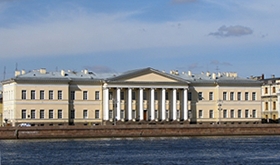 .
.